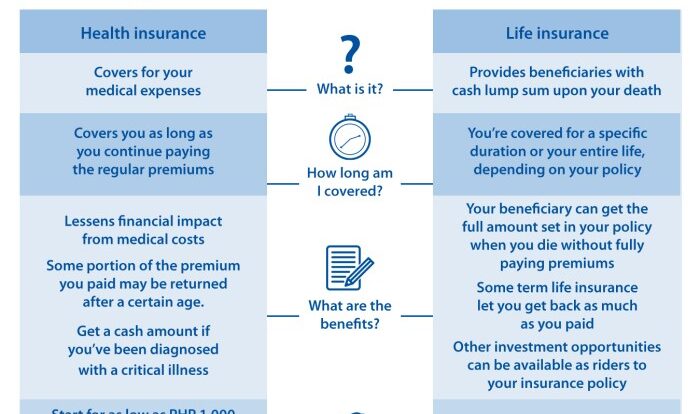
Tell me about life insurance – a question that delves into the realm of financial security and peace of mind. Life insurance serves as a cornerstone of responsible financial planning, providing a safety net for loved ones in the event of life’s unexpected turns.
From term life to whole life policies, understanding the nuances of life insurance empowers individuals to make informed decisions that safeguard their families’ financial well-being. This comprehensive guide unravels the complexities of life insurance, offering clarity and guidance to navigate this essential aspect of financial planning.
Life Insurance Overview

Life insurance is a contract between an insurance company and an individual, in which the insurance company agrees to pay a sum of money to the individual’s beneficiaries upon their death. Life insurance can provide financial security for the individual’s loved ones in the event of their untimely demise.
There are various types of life insurance policies, including:
- Term life insurance:Provides coverage for a specific period, such as 10, 20, or 30 years. If the insured individual dies within the term, the beneficiaries receive the death benefit.
- Whole life insurance:Provides coverage for the entire life of the insured individual. The policy also accumulates a cash value component, which can be borrowed against or withdrawn.
- Universal life insurance:Offers flexible coverage and premium payments. The policyholder can adjust the death benefit and premium payments based on their financial needs.
- Variable life insurance:Links the death benefit to the performance of an investment portfolio. The policyholder has the potential to earn higher returns, but also faces the risk of losing money if the investments perform poorly.
Life insurance plays a crucial role in financial planning. It provides peace of mind knowing that the insured individual’s loved ones will be financially protected in the event of their death. Life insurance can also be used to cover specific financial obligations, such as a mortgage or college tuition.
Benefits and Coverage
Life insurance policies offer various benefits and protections, providing financial security for families and loved ones in the event of the policyholder’s untimely demise. These policies ensure that financial obligations and expenses can be met, such as mortgage payments, outstanding debts, funeral costs, and income replacement for dependents.
Additionally, riders and additional benefits can enhance coverage, offering options such as accidental death and dismemberment coverage, waiver of premium in case of disability, and coverage for critical illnesses. These riders provide peace of mind and comprehensive protection against unforeseen circumstances.
Types of Life Insurance Policies
There are two main types of life insurance policies: term life insurance and permanent life insurance.
- Term Life Insurance:Provides coverage for a specific period, such as 10, 20, or 30 years. If the policyholder dies during the coverage period, the beneficiaries receive the death benefit. However, if the policyholder outlives the term, the policy expires without any payout.
- Permanent Life Insurance:Provides lifelong coverage, regardless of when the policyholder dies. Permanent life insurance policies also have a cash value component that grows over time, which can be borrowed against or withdrawn for various purposes.
Choosing the Right Life Insurance Policy
When choosing a life insurance policy, consider factors such as age, health, financial situation, and family responsibilities. It’s crucial to assess the amount of coverage needed to meet financial obligations and provide for loved ones.
Choosing the Right Policy: Tell Me About Life Insurance

Selecting the right life insurance policy is crucial to ensure adequate financial protection for your loved ones. Consider these factors when making your decision:
Factors to Consider:
- Age and health:Younger and healthier individuals typically qualify for lower premiums.
- Occupation and lifestyle:Hazardous occupations or risky hobbies may impact premiums.
- Income and expenses:Coverage should align with your financial obligations and future earning potential.
- Family responsibilities:Consider the number of dependents and their financial needs.
- Investment goals:Some policies offer cash value accumulation features that can complement your financial strategy.
Types of Policies
Choose between different policy types based on your needs:
- Term life insurance:Provides coverage for a specific period, typically 10-30 years. Premiums are generally lower than whole life policies.
- Whole life insurance:Offers lifelong coverage with a cash value component that grows over time. Premiums are higher than term life but provide additional benefits.
- Universal life insurance:A flexible policy that allows you to adjust premiums and coverage amounts over time.
Determining Coverage Amount
Calculate the appropriate coverage amount to ensure your loved ones are financially protected:
- Estimate final expenses:Include burial costs, medical bills, and other immediate expenses.
- Consider outstanding debts:Mortgage, car loans, and credit card balances.
- Provide income replacement:Calculate the income needed to support your family for a specific period.
- Factor in education and future expenses:Consider the costs of education and other expenses for your dependents.
- Seek professional advice:A financial advisor can help you determine the optimal coverage amount.
Premiums and Costs

Life insurance premiums are calculated based on various factors that assess the risk associated with insuring an individual. These factors include age, health, coverage amount, and lifestyle choices. The higher the risk, the higher the premium. Conversely, lower-risk individuals typically pay lower premiums.
Factors Influencing Premium Rates
- Age:Younger individuals generally pay lower premiums than older individuals due to their lower mortality risk.
- Health:Individuals with good health habits and no major medical conditions typically qualify for lower premiums than those with pre-existing conditions or unhealthy lifestyles.
- Coverage Amount:The amount of coverage you choose also affects your premium. Higher coverage amounts result in higher premiums.
- Lifestyle Choices:Certain lifestyle choices, such as smoking or engaging in high-risk activities, can increase your premium rates.
Comparing Premium Costs
When comparing premium costs from different insurance providers, it’s important to consider not only the monthly or annual premium but also the total cost of the policy over the life of the insured individual. Factors to consider include:
- Policy Term:The length of time the policy is in effect. Longer policy terms typically result in higher premiums.
- Riders and Add-Ons:Additional coverage options, such as accidental death benefits or waiver of premium riders, can increase your premium.
- Insurance Company:Different insurance companies have different underwriting guidelines and risk assessment methods, which can impact premium rates.
It’s recommended to obtain quotes from multiple insurance providers to compare premium costs and coverage options before making a decision.
Beneficiaries and Claims
Beneficiaries are individuals or entities designated to receive the death benefit from a life insurance policy. Naming beneficiaries is crucial to ensure that the proceeds are distributed according to your wishes. Beneficiaries can be family members, friends, or even charitable organizations.When purchasing a life insurance policy, you will need to complete a beneficiary designation form.
This form will allow you to specify who will receive the death benefit and in what proportion. You can also name contingent beneficiaries who will receive the benefit if your primary beneficiaries are deceased or unable to receive it.It’s important to keep your beneficiaries informed and up-to-date on your life insurance policy.
This includes providing them with a copy of the policy and any relevant contact information. You should also review your beneficiary designations regularly to ensure that they are still accurate.
Filing a Life Insurance Claim
When the insured individual passes away, the beneficiaries must file a claim with the life insurance company. The claim process typically involves submitting the following documents:
- A death certificate
- A copy of the life insurance policy
- Proof of the beneficiary’s identity
The insurance company will review the claim and determine if it is valid. If the claim is approved, the death benefit will be paid to the beneficiaries.It’s important to file a life insurance claim as soon as possible after the insured individual’s death.
Most insurance companies have a time limit for filing claims, so it’s important to act promptly.
Legal and Tax Implications

Life insurance policies have specific legal and tax implications that policyholders should be aware of. These include ownership and assignment of policies, as well as income and estate tax considerations.
Life insurance policies are legal contracts between the policyholder and the insurance company. The policyholder agrees to pay premiums in exchange for a death benefit that will be paid to the beneficiary upon the policyholder’s death.
Ownership and Assignment
The policyholder has the right to own and assign the policy. This means that the policyholder can change the beneficiary or transfer ownership of the policy to another person.
Tax Implications
Life insurance benefits are generally not taxable for income tax purposes. However, there are some exceptions to this rule. For example, if the policyholder receives a loan from the insurance company, the loan proceeds may be taxable as income.
Life insurance proceeds may also be subject to estate tax. Estate tax is a tax on the value of a person’s assets at the time of their death. If the death benefit from a life insurance policy is included in the policyholder’s estate, it may be subject to estate tax.
Life Insurance as an Estate Planning Tool
Life insurance can be used as an estate planning tool to help reduce the amount of estate tax owed. By purchasing a life insurance policy, the policyholder can create an asset that will not be included in their estate for estate tax purposes.
Industry Trends and Regulations
The life insurance industry is constantly evolving to meet the changing needs of consumers. Some key trends include:
- The use of technology to streamline the application and underwriting process.
- The development of new products that provide more flexibility and customization.
- The increasing popularity of term life insurance, which offers lower premiums than permanent life insurance.
The life insurance industry is regulated by state insurance departments. These departments ensure that insurers are financially sound and that they treat consumers fairly. Consumers should compare quotes from several insurers before purchasing a life insurance policy.
Choosing a Reputable Life Insurance Provider
When choosing a life insurance provider, it is important to consider the following factors:
- The company’s financial strength.
- The company’s customer service record.
- The company’s product offerings.
- The company’s premiums and fees.
Consumers can find information about life insurance companies from a variety of sources, including the National Association of Insurance Commissioners (NAIC) and the Better Business Bureau (BBB).
Additional Considerations
When purchasing life insurance, it’s essential to consider various factors beyond your age and health. Lifestyle choices, future financial goals, and other aspects can impact your coverage needs and policy choices.
Health Conditions and Lifestyle Choices
Your health and lifestyle choices can significantly influence your life insurance premiums. Insurers assess your overall health, including any pre-existing conditions or potential risk factors, to determine your risk level. Smokers, for instance, typically pay higher premiums due to the increased risk of health complications.
Similarly, individuals with certain medical conditions may face higher rates or limited coverage options.
Future Financial Goals, Tell me about life insurance
Consider your future financial goals when determining the amount of life insurance coverage you need. If you have dependents or significant financial obligations, such as a mortgage or business, a larger policy may be necessary to ensure their financial well-being in the event of your untimely demise.
Insurance Agents and Financial Advisors
Insurance agents and financial advisors can provide valuable guidance and support throughout the life insurance purchasing process. They can help you assess your needs, compare policies from different providers, and negotiate the best possible premiums. Working with a reputable and experienced professional can help you make informed decisions and secure the most appropriate coverage for your specific circumstances.
Negotiating Premiums
Negotiating premiums with insurance companies is possible, especially if you’re in good health and have a clean driving record. You can request discounts for factors such as non-smoking status, healthy lifestyle habits, and safe driving practices. Comparing quotes from multiple insurers can also help you find the most competitive rates.
End of Discussion

In the tapestry of life, life insurance stands as a pillar of protection, ensuring financial stability for those left behind. By carefully considering factors such as coverage amount, premiums, and beneficiaries, individuals can tailor a life insurance policy that aligns with their unique needs and aspirations.
As the world evolves, so too does the life insurance landscape. Staying abreast of industry trends and regulations empowers consumers to make informed choices and secure the best possible coverage for their loved ones. Remember, life insurance is not just a policy; it’s an investment in the future, a testament to love and responsibility.
Detailed FAQs
What is the purpose of life insurance?
Life insurance provides a financial safety net for loved ones in the event of the policyholder’s death, ensuring their financial well-being and stability.
What are the different types of life insurance policies?
Common types include term life insurance (coverage for a specific period) and whole life insurance (coverage for the entire life of the insured).
How do I determine the right coverage amount?
Consider factors such as income, debts, family size, and future financial goals to determine an appropriate coverage amount.
What factors influence life insurance premiums?
Premiums are influenced by age, health, coverage amount, and lifestyle factors like smoking.
How do I file a life insurance claim?
Contact the insurance provider and provide necessary documentation, such as the death certificate and policy details.

